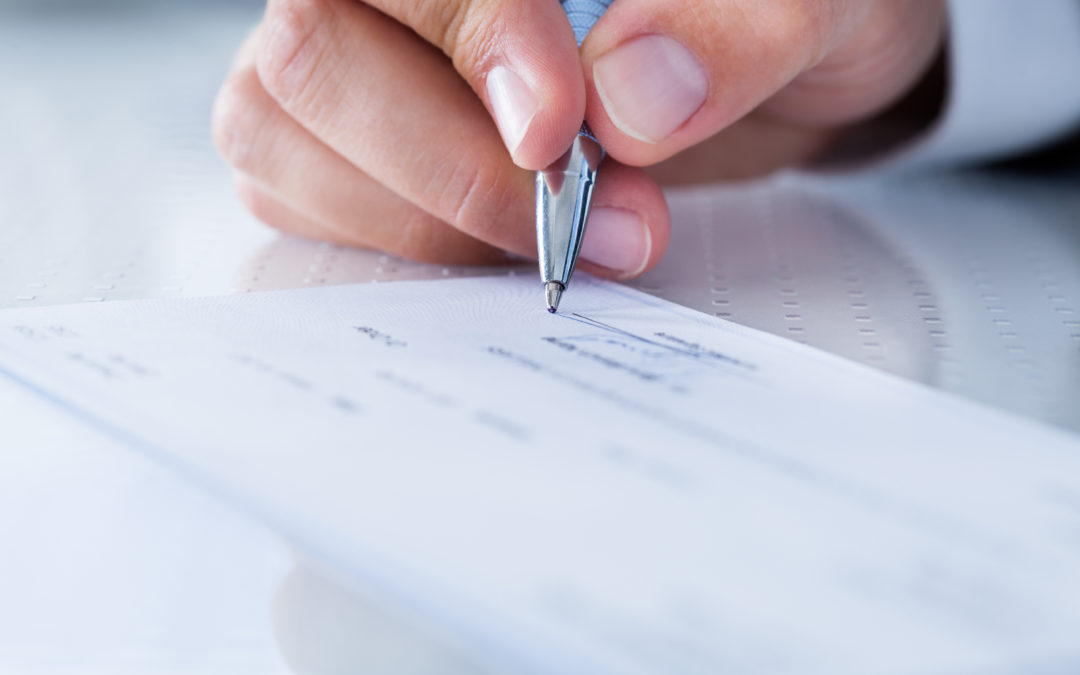Check those checks closely. Although debit cards, electronic funds transfers, and other high-tech ways of moving and paying money have become popular, check fraud remains a risk for businesses and other organizations. According to the most recent fraud survey by the Association for Financial Professionals, “In 2020, checks and wire transfers continued to be the payment methods most impacted by fraud activity.” With the pervasiveness of this crime, it is important to know the five primary types of check fraud and take steps to combat them.
Types of Check Fraud
1. Counterfeiting. This can range from creating fake checks using easily acquired sophisticated desktop publishing equipment or simply duplicating checks with advanced color photocopiers.
2. Alterations. Scammers use chemicals and solvents such as acetone, brake fluid, and bleach to remove or modify such information as the name of a payee or the amount of a check. Criminals can either alter small areas of a check, known as spot washing, or alter the full check, a process called check washing.
3. Forgery. For businesses, check forgeries typically involve employees issuing a check without authorization, forging an official signature and making the check payable to themselves or an accomplice. Forgeries also occur when checks are stolen and fraudulently endorsed to someone other than the intended payee.
4. Closed accounts. Also known as paperhanging, this involves writing checks against accounts that are closed and contain no funds.
5. Kiting. This fraud involves opening checking accounts at two or more institutions and covering checks drawn on one account with deposits of checks from the other account that does not have funds. By relying on the float time involved in processing checks, the fraudster carefully times deposits of the worthless checks to artificially inflate the balance of an account.
Prevention
The key to preventing check fraud involves recognizing not only the type of check fraud, but also how — and by whom — the particular fraud is typically committed. Your accountant can advise you about the red flags for each type of fraud.
Different rules and regulations apply to the way your organization’s bank handles losses from the various types of check fraud. Techniques for investigating fraud involving an employee, for instance, will differ from those used to look into counterfeit checks.
To detect and prevent check fraud, your company should focus on both internal and external efforts.
Internal – Review your organization’s controls related to receiving, storing, and issuing checks. Among other things, your business should reconcile bank statements in a timely manner, segregate check writing from account reconciliation, and limit the number of employees with signing authority. You may want to get a professional assessment of your organization’s controls.
External – Talk to your bank about ways it can help protect your account. The cost may depend on the size of the bank and the volume of checks your business issues. One defense most banks offer is called Positive Pay. In its simplest form, this process matches the account number, check number, and dollar amount of each check against a list of checks your company has previously authorized and issued. The bank will not cash the check unless all three components match.
Response
If your organization is — or suspects it is — the victim of check fraud, contact law enforcement officials, your attorney, and your accountant. They will know how to handle the investigation and can offer guidance on the best practices to prevent and investigate crime at your business.
Next Steps
Familiarize yourself with the types of check fraud and begin taking action to protect your organization. A good place to begin is with our free diagnostic, which allows you to evaluate your internal controls. You can also contact a team member if you have specific questions or need advice. Our team is here to help you take the right next step.
Contact Us
© Copyright 2022 Thomson Reuters.
Disclaimer of Liability
Our firm provides the information in this article for general guidance only, and does not constitute the provision of legal advice, tax advice, accounting services, investment advice or professional consulting of any kind. The information provided herein should not be used as a substitute for consultation with professional tax, accounting, legal or other competent advisors. Before making any decision or taking any action, you should consult a professional advisor who has been provided with all pertinent facts relevant to your particular situation. Tax articles in this blog are not intended to be used, and cannot be used by any taxpayer, for the purpose of avoiding accuracy-related penalties that may be imposed on the taxpayer. The information is provided “as is,” with no assurance or guarantee of completeness, accuracy or timeliness of the information, and without warranty of any kind, express or implied, including but not limited to warranties of performance, merchantability and fitness for a particular purpose.
Blog
Nonprofit Insights

